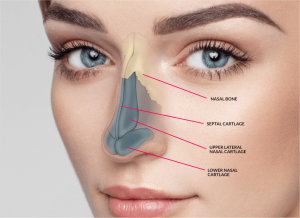Ethnic Rhinoplasty Explained
by Admin
Posted on 07-12-2024 06:48 AM

Understanding Ethnic Rhinoplasty
Ethnic rhinoplasty is a specialized form of nose surgery tailored to meet the unique needs of individuals from diverse backgrounds. Unlike traditional rhinoplasty, it considers the distinct facial features and cultural aesthetics of various ethnicities. This approach helps to ensure that the results are harmonious with the individual’s overall appearance.
Many people seek ethnic rhinoplasty to enhance their facial symmetry while still preserving their cultural identity. Understanding these nuances is crucial for both patients and surgeons. It’s not just about making a nose smaller or more refined; it’s about achieving the right balance that reflects the patient's ethnicity.
Why Choose Ethnic Rhinoplasty?
Choosing ethnic rhinoplasty can stem from a desire to correct functional issues or enhance aesthetic appeal. Some common reasons include improving breathing difficulties or modifying a nose that may be perceived as too large, wide, or bulbous. Ultimately, it's about *finding the best fit* for the individual’s unique features.
Additionally, many patients wish to maintain aspects of their ethnic heritage while achieving their desired look. This dual focus on function and form is what sets ethnic rhinoplasty apart. Therefore, finding a surgeon who understands these cultural sensitivities is vital.
- Enhancing facial balance
- Correcting structural issues
- Preserving ethnic identity
Consultation Process
The consultation for ethnic rhinoplasty is a critical step in the journey. During this meeting, patients discuss their goals and expectations with the surgeon. Clear communication about what the patient wants is essential. It allows for a tailored approach that aligns with the individual’s vision.
Surgeons often use digital imaging to show potential outcomes, which helps patients visualize the changes. It’s important to ask questions and express any concerns during this process. This collaborative effort ensures that the final result is satisfying and true to the patient's identity.
- Discuss goals and expectations
- Review medical history
- Explore potential techniques
Techniques Used in Ethnic Rhinoplasty
Ethnic rhinoplasty can involve various techniques to achieve the desired results. Surgeons may opt for open or closed rhinoplasty methods, depending on the specific changes needed. Open rhinoplasty offers better visibility and is often used for more complex adjustments, while closed rhinoplasty is less invasive with no external incisions.
In addition to the surgical approach, techniques may also include grafting or augmentation to create a more balanced profile. This is especially common when working with ethnic features that may require structural enhancement or refinement for a more proportionate appearance.
Recovery and Results
Recovery from ethnic rhinoplasty typically involves swelling and bruising, which can last several weeks. Following the surgeon’s post-operative care instructions is crucial for optimal healing. Most patients can return to light activities within a week, but it may take several months to see the final results.
While each individual heals differently, patience is key. The end result should reflect both the changes desired and the patient's unique ethnic traits. Regular follow-ups with the surgeon are essential to monitor healing and address any concerns.
- Swelling and bruising are common
- Follow post-operative care instructions
- Final results may take months to fully reveal
Choosing the Right Surgeon
Finding the right surgeon is one of the most important steps in the ethnic rhinoplasty journey. Look for a surgeon who specializes in this area and has experience working with diverse ethnic backgrounds. It’s essential that they understand the artistic and technical aspects of the procedure.
During consultations, don’t hesitate to ask for before-and-after photos of previous patients. This can provide insight into the surgeon's style and results. Trust your instincts; you want to feel comfortable and confident in your choice!
Conclusion
Ethnic rhinoplasty is a personalized approach to enhancing facial aesthetics while honoring cultural identity. Understanding the nuances and finding the right surgeon can lead to satisfying results. Remember, the goal is to enhance beauty in a way that feels authentic to you!
If you're considering this type of procedure, I encourage you to research and ask questions. The more informed you are, the better prepared you’ll be to achieve the look you desire while embracing your unique heritage.
FAQs about Ethnic Rhinoplasty
- What is ethnic rhinoplasty?
Ethnic rhinoplasty is a specialized form of nose surgery designed to meet the unique needs of individuals from diverse backgrounds, focusing on preserving cultural identity while enhancing facial features. - Why choose ethnic rhinoplasty?
Patients may choose ethnic rhinoplasty to correct functional issues, enhance aesthetic appeal, or maintain aspects of their ethnic heritage while achieving their desired look. - What is the consultation process like?
The consultation involves discussing goals and expectations with the surgeon, reviewing medical history, and exploring potential techniques to tailor the procedure to the individual’s vision. - What techniques are used in ethnic rhinoplasty?
Techniques may include open or closed rhinoplasty methods, grafting, or augmentation to create a balanced profile, depending on the specific changes needed. - What is the recovery process like?
Recovery typically includes swelling and bruising that may last several weeks, with most patients returning to light activities within a week, though final results can take months to fully reveal. - How do I choose the right surgeon for ethnic rhinoplasty?
Look for a surgeon specializing in ethnic rhinoplasty with experience working with diverse backgrounds, and ask to see before-and-after photos of their previous work to assess their style and results. - What should I expect from the results?
The end result should reflect the desired changes while honoring the patient's unique ethnic traits, ensuring a harmonious balance with their overall appearance.
